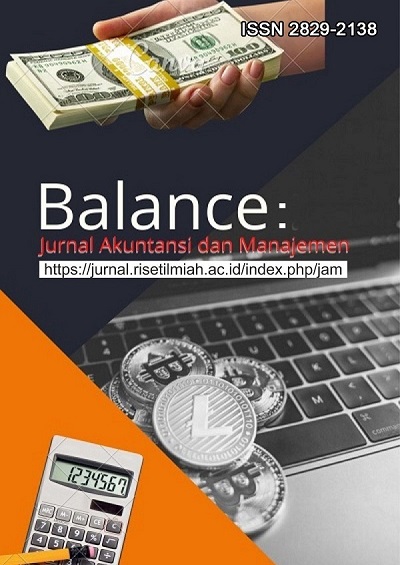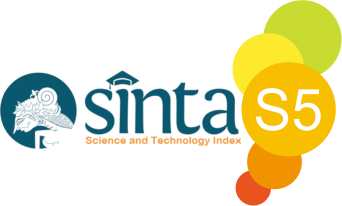Pengaruh Strategi Cost Leadership Terhadap Potensi Financial Distress Pada Sektor Manufaktur Dengan Kinerja ESG Sebagai Variabel Mediasi
DOI:
https://doi.org/10.59086/jam.v4i2.1052Keywords:
Financial Distress, Cost Leadership, Kinerja ESGAbstract
This study aims to examine the effect of cost leadership strategy, ESG performance, and financial distress. The population consists of manufacturing companies listed on the Indonesia Stock Exchange (IDX) during the 2019–2023 period. The sampling technique used was purposive sampling, resulting in 95 data observations. The data were analyzed using logistic regression with SPSS 25. The results show that cost leadership strategy has a positive and significant effect on ESG performance, ESG performance has a positive and significant effect on financial distress, cost leadership strategy has a negative and significant effect on financial distress, and ESG performance can mediate the relationship between cost leadership strategy and financial distress. This study contributes by demonstrating the role of cost leadership and ESG performance as a mechanism for mitigating financial distress risk in Indonesian manufacturing companies, while also enriching the literature on business strategy and sustainable finance.
Downloads
References
Achyani, M. N., & Kusumawati, E. (2023). Pengaruh Profitability, Leverage, Liudity dan Good Corporate Governance terhadap Financial Distress. Makensi, 12(4), 899–908.
Adriyani, Z., & Prabowo, T. J. W. (2024). Pengaruh Praktik Pengungkapan ESG Terhadap Risiko Financial Distress Perusahaan dengan Nilai Perusahaan Sebagai Variabel Mediasi. Diponegoro Journal of Accounting, 13(2019), 1–15.
Aisyah, S., & Mulyani, S. D. (2024). Pengaruh Pengungkapan ESG dan Profititabilitas Terhadap Financial Distress Dengan Firm Life Cycle Sebagai Variabel Moderasi. Jurnal Ekonomi Trisakti, 4(1), 373–384.
Alsayegh, M. F., Rahman, R. A., & Homayoun, S. (2020). Corporate Economic , Environmental , and Social Sustainability Performance Transformation through ESG Disclosure. Sustainability, 12, 1–20.
Angelina, C., Sharon, Lim, S., Lombogia, J. Y. R., & Aruan, D. A. (2020). Pengaruh Current Ratio, Debt to Equity, Perputaran Kas dan Total Asset TurnOver (TATO) Terhadap Profitabilitas pada Perusahaan Food & Beverages yang terdaftar di Bursa Efek Indonesia. Owner : Riset & Jurnal Akuntansi, 4(1), 16.
Antunes, J., Wanke, P., Fonseca, T., & Tan, Y. (2023). Do ESG Risk Scores Influence Financial Distress ? Evidence from a Dynamic NDEA Approach. Sustainability, 15, 1–32.
Asher, S., Martusa, R., Meythi, M., & Rapina, R. (2025). The Impact of Cost Leadership on Financial Distress Mediated Environmental, Social and Governance. Jurnal Akuntansi Dan Keuangan Indonesia, 22(1), 1–22.
Bao, X., Sadiq, M., Tye, W., & Zhang, J. (2024). The impact of environmental , social , and governance ( ESG ) rating disparities on corporate risk : The mediating role of financing constraints. Journal of Environmental Management, 371, 1–9.
Bhandari, K. R., Ranta, M., & Salo, J. (2022). The resource-based view , stakeholder capitalism , ESG , and sustainable competitive advantage : The firm’s embeddedness into ecology , society , and governance. Business Strategy and The Environment, 31(April 2025), 1525–1537.
BPS. (2024). Ekspor Desember 2023 mencapai US$22,41 miliar, naik 1,89 persen dibanding November 2023 dan Impor Desember 2023 senilai US$19,11 miliar, turun 2,45 persen dibanding November 2023. Badan Pusat Statistik.
Brigham, E. F., & Daves, P. R. (2014). Intermediate Financial Management. Cengage Learning.
Dari, S. wulan. (2024). Pengaruh Strategi Bisnis dan Karakteristik Dewan Terhadap Financial Distress Pada Perusahaan Yang Terdaftar Di BEI. 1–11.
Dasuki, R. E. (2021). Manajemen Strategi : Kajian Teori Resource Based View. Jurnal Ilmiah Manajemen, 12(3), 447–454.
Fauziah, S. N., & Herawaty, V. (2023). Pengaruh Bisnis Strategi, Market Effect, dan Manajemen Laba Terhadap Risiko Kebangkrutan Dengan Pandemi COVID-19 sebagai Variabel Moderasi. Jurnal Ekonomi Trisakti, 3(1), 1209–1218.
Galant, A., & Zenzerović, R. (2023). Can corporate Social Responsibility Contribute to Bankruptcy Prediction ? Evidence from Croatia. Organizacija, 56(3), 173–183. https://doi.org/10.2478/orga-2023-0012
Ghozali, I. (2021). Aplikasi Analisis Multivariate dengan Program IBM SPSS 26. Universitas Diponegoro.
Habib, A. M. (2023). Do business strategies and environmental, social, and governance (ESG) performance mitigate the likelihood of financial distress? A multiple mediation model. Heliyon, 9(7).
Habib, A. M., & Mourad, N. (2024). The Influence of Environmental , Social , and Governance (ESG) Practices on US Firms’Performance : Evidence from the Coronavirus Crisis. Journal of the Knowledge Economy, 15, 2549–2570.
Hernadianto, Yusmaniarti, & Fraternesi. (2020). Analisis Financial Distress Pada Perusahaan Jasa Subsektor Property Dan Realestate Yang Terdaftar Di Bursa Efek Indonesia. Jurnal Sains Manajemen Dan Bisnis Indonesia, 10(1), 80–102.
Kontan. (2023). Kinerja Mayoritas Emiten Tekstil Anjlok, Begini Tanggapan APSyFI.
Larasati, R. A., & Mawardi, W. (2024). Pengaruh Strategi Bisnis dan Kinerja ESG (Environmental, Social and Governance) Terhadap Risiko Financial Distress (Studi pada Perusahaan Manufaktur yang Terdaftar di BEI Periode 2018-2022). Diponegoro Journal of Mangement, 13, 1–13.
Lubis, N. W. (2022). Resource Based View ( RBV ) in Improving Company Strategic Capacity. Research Horizon, 2(6), 587–596.
Lukason, O., & Minano, M. del M. C. (2019). Bankruptcy Risk , Its Financial Determinants and Reporting Delays : Do Managers Have Anything to hide? Risks.
Luthan, E., Irfan, M., & Bahari, A. (2025). Pengaruh Strategi Bisnis dan Kinerja ESG terhadap Potensi Financial Distress pada Perusahaan di Negara-Negara ASEAN. Riset & Jurnal Akuntansi, 9, 85–99.
Porter, M. E. (1980). Competitive Strategy: Techniques for Analyzing Industries and Competitors. New York: Free Press.
Porter, M. E. (1985). Competitive Advantage: Creating and Sustaining Superior Performance. New York: Free Press.
Prameswari, S. N., Novita, & Fambudi, I. N. (2024). The Influence of ESG Disclosures on Financial Distress Considering The Director’s Financial Expertise as a Moderating Factor. Jurnal Riset Akuntansi Dan Keuangan, 12(1), 805–818.
Prasetiyo, Y. (2024). Analisis Hubungan Firm Size, Audit Quality, dan Kinerja Keuangan Dengan Financial Distress. Jurnal Akademi Akuntansi Indonesia Padang, 4(1), 18–27.
Purnomo, T. A. W. H., Kusuma, S. A. D., & Amelia, C. (2023). Pengungkapan Esg: Cara Efektif Untuk Mencapai Bisnis Berkelanjutan? Jurnal Riset Akuntansi Dan Keuangan, 19(1), 15.
Ramadhan, Y., Arifin, M. R., Sinaga, E., Talaohu, A. P., & Lisbeth, N. (2023). Praktik Pengungkapan Informasi Environment, Social and Governance (ESG) terhadap Kinerja Perusahaan. 6(1), 140–147.
Ruan, L., & Liu, H. (2021). Environmental, social, governance activities and firm performance: evidence from China. Sustainability (Switzerland), 13(2), 1–16. https://doi.org/10.3390/su13020767
Saputra, A. N., & Kusumastuti, R. (2023). Pengaruh Rasio Profitabilitas, Arus Kas, Nilai Tukar, Suku Bunga, dan Inflasi pada Financial distress pada Perusahan Manufaktur. EKALAYA : Jurnal Ekonomi Akuntansi, 1(Persediaan), 1–12.
Sawitri, R. (2025). Pengaruh Manajemen Laba , Strategi Bisnis , dan Kepemilikan Manajerial Terhadap Financial Distress ( Studi Empiris pada Perusahaan Manufaktur Sub Sektor Technology di BEI 2019-2023 ). 412–422.
Sayudin, S. (2023). Membentuk Strategi Bisnis Yang Tangguh Dalam Era Manajemen Yang Berubah. Jurnal Multidisiplin Indonesia, 2(7), 1566–1572.
Setiawan, D., & Farida, I. (2022). Business Strategies and Competitive Advantage: The Role of Performance and Innovation. Jurnal of Open Innovation, 8(2), 201–226.
Sugiyono. (2024). Metode penelitian kuantitatif, kualitatif dan kombinasi (mixed methods). Alfabeta.
Theodora, A. (2023). Sinyal Pelemahan Industri di Balik Turunnya Kinerja Impor. Kompas.
Thu, Q. L. (2023). Impact of earning management and business strategy on financial distress risk of Vietnamese companies. Cogent Economics & Finance, 11(1), 1–21.
Ukko, J., Nasiri, M., Saunila, M., & Rantala, T. (2019). Sustainability strategy as a moderator in the relationship between digital business strategy and financial performance. Journal of Cleaner Production, 236.
Widjaja, A. W., & Yuga, A. T. (2020). Is the RBV Theory Important for MSMEs? : Competitive Advantage Analysis of Tokopedia Seller With Resource Based Theory Views. SSRN Electronic Journal.
Downloads
Published
How to Cite
Issue
Section
License
Copyright (c) 2025 Nindola Nainekklesia Tuswajati, Suci Atiningsih

This work is licensed under a Creative Commons Attribution 4.0 International License.
This is an open-access journal. All works are published under the Creative Commons license CC-BY which means that all content is freely available at no charge to the user or his/her Institution. Users are allowed to read, download, copy, write, improve, and create derivative creation even for other lawful purposes, this license permits anyone to, as long as they cite and license the derivative creation under similar terms

This work is licensed under a Creative Commons Attribution 4.0 International License.
Most read articles by the same author(s)
- Imam Tri Kuncoro , Suci Atiningsih , Pengaruh Environmental, Social, And Governance (ESG) Performance Dan Corporate Tax Avoidance Terhadap Nilai Perusahaan Dengan Ownership Concentration Sebagai Variabel Moderasi , Balance : Jurnal Akuntansi dan Manajemen: Vol. 4 No. 2 (2025): Agustus 2025
- Inda Paramita, Suci Atiningsih , Pengaruh Resiko Kredit Dan Resiko Likuiditas Terhadap Profitabilitas , Balance : Jurnal Akuntansi dan Manajemen: Vol. 4 No. 2 (2025): Agustus 2025


















